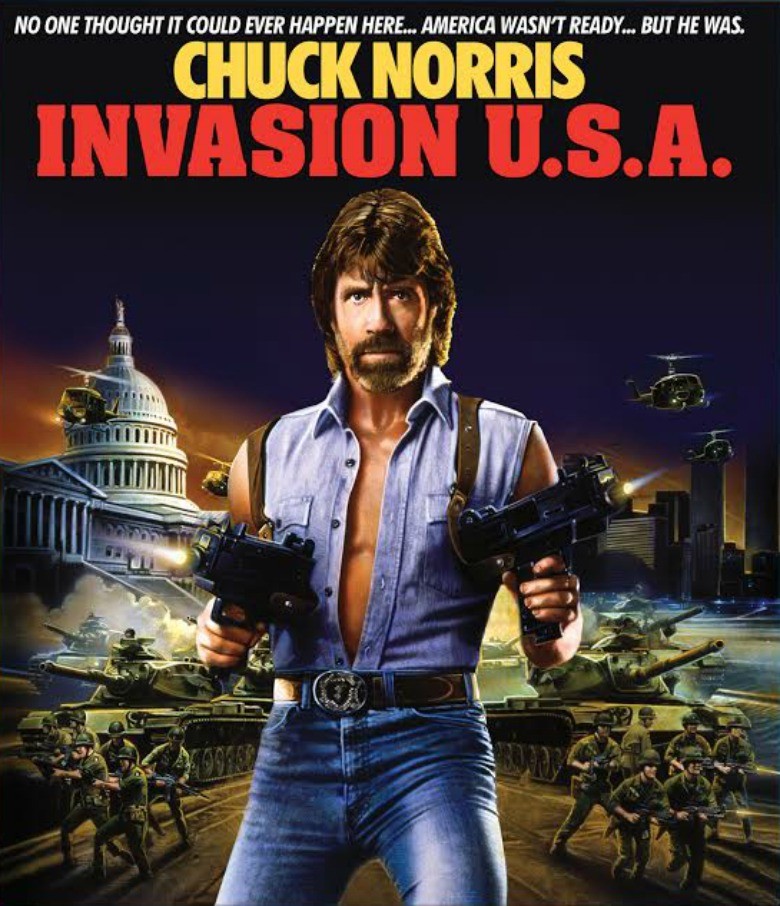 This Tuesday, March 15th, Shout! Factory releases the Blu-ray debuts of the Chuck Norris classics Invasion U.S.A. and Braddock: Missing in Action III. As anyone with a working wifi connection since 2005 will tell you, the Internet’s at no shortage of Chuck Norris jokes, but the quality of the score of his films are no laughing matter. Any while the stories are in no way intertwined, both Invasion U.S.A. and Braddock: Missing in Action III share quite a bit in common. While the aesthetic of the posters alone were probably enough to tip you off that both star Chuck Norris and were released by Cannon Pictures, what we at the Weekly find interesting is both were scored by composer Jay Chattaway. Some Norris devotees reading this may recognize his name from also scoring the original Missing in Action, and while his scores for both of the those films were great (the first installment frequently being used to-this-day in workprints of industry action movies as something of a place-holder score), there’s something we find absolutely perfect about Chattaway’s work on Invasion U.S.A.
This Tuesday, March 15th, Shout! Factory releases the Blu-ray debuts of the Chuck Norris classics Invasion U.S.A. and Braddock: Missing in Action III. As anyone with a working wifi connection since 2005 will tell you, the Internet’s at no shortage of Chuck Norris jokes, but the quality of the score of his films are no laughing matter. Any while the stories are in no way intertwined, both Invasion U.S.A. and Braddock: Missing in Action III share quite a bit in common. While the aesthetic of the posters alone were probably enough to tip you off that both star Chuck Norris and were released by Cannon Pictures, what we at the Weekly find interesting is both were scored by composer Jay Chattaway. Some Norris devotees reading this may recognize his name from also scoring the original Missing in Action, and while his scores for both of the those films were great (the first installment frequently being used to-this-day in workprints of industry action movies as something of a place-holder score), there’s something we find absolutely perfect about Chattaway’s work on Invasion U.S.A.
Chattaway is probably best known for his contribution to numerous Star Trek franchises, most notably for Star Trek: Voyager, which won him an Emmy in 2001. But going back a few decades in his film career, outside of uncredited work on the Sophia Loren film Firepower, Chattaway had his debut crafting the music for the William Lustig cult classic Maniac. A truly groundbreaking score, the combination of electronic and acoustic elements would create an unsettling tension and offer a glimpse of the composer’s ability to incorporate dueling elements during one of the medium’s greater times of transition. But crossing film music across genres was nothing foreign to Chattaway, he had previous produced Maynard Ferguson’s Grammy-nominated jazz fusion rendition of “Gonna Fly Now (Theme From Rocky)” which landed him a Gold single in 1977.
The approach of a previously unheard of collision of styles works perfectly for a film like Invasion U.S.A., which centers around the suburbs of 1980s America being invaded for the first time by foreign terrorist mercenaries, and the ever-stoic Chuck Norris as the one retired agent who can stop it. The often overlooked element of Invasion U.S.A. is that it takes place at Christmastime, which, along with now allowing you to one-up that guy trying to hard at this year’s holiday party claiming Die Hard is his “favorite Christmas movie,” gives the whole endeavor a strong sentimental core to work with. Along with the obvious “how dare these terrorists attack us, especially at Christmas!” it allows for Chattaway to work with the elements of Christmas music, both as diegetic and non-diegetic sound. We hear instrumentals of familiar carols in between the scenes, as Chattaway’s both symphonic and electronic elements overpower them in different scenes. The holidays are being disrupted, even in the music!
But these aren’t the only elements of the music that set the tone of Invasion U.S.A. apart from the film’s contemporaries. In 1985, when most action films’ score were largely rock influenced, effectively turning the silver screen into an explosive concert-like atmosphere, Chattaway’s compositions are uncompromisingly militant, adding an urgency that propels the film along. This fantastic strength of Chattaway’s repertoire we’d venture to guess comes from his experience serving for seven years as Chief Arranger and Composer-in-Residence with the U.S. Navy Band in Washington, DC. Invasion U.S.A.’s drums in particular are a rapidfire staccato, vastly different from the driving snare/bass drum that was popular with action scores at the time.
It’s also a telling element that we aren’t submerged in synths until about halfway through the film in the car-chase after the attack at the mall. Here, their warble effectively conveys the Chuck Norris standing up for American stability disrupting the foreign disruptors themselves, and the various sounds and cues transition in-and-out and continue to re-emerge at different points throughout the rest of the film. By the time the last bad guy gets blown up and the credits immediately roll, it becomes clear that the film’s entire story could be told through the music itself, which for something that’s so subtle about its own complexity, might be the highest praise one could grant it.
While we’re not necessarily presumptuous enough to say that Invasion U.S.A.’s status as “the greatest Chuck Norris film score” is a “Chuck Norris Fact,” we’ll put our money on it being a “Chuck Norris Well-Informed Opinion” any day of the week. Beard optional.

